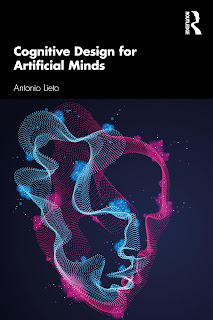Cognitive Design for Artificial Minds
I am really glad to announce my forthcoming book "Cognitive Design for Artificial Minds" that will be published in 2021 by Taylor & Francis (T&F).
The book can already be pre-ordered in the main online bookshops (e.g. from Routledge (T&F) to Amazon Walmart Barnes& Noble etc.)
I am posting below the "blurb" and the Table of Contents of the Book from the Routledge website (T&F).
Cognitive Design for Artificial Minds explains the crucial role that human cognition research plays in the design and realization of artificial intelligence systems, illustrating the steps necessary for the design of artificial models of cognition. It bridges the gap between the theoretical, experimental and technological issues addressed in the context of AI of cognitive inspiration and computational cognitive science.
Beginning with an overview of the historical, methodological and technical issues in the field of Cognitively-Inspired Artificial Intelligence, Lieto illustrates how the cognitive design approach has an important role to play in the development of intelligent AI technologies and plausible computational models of cognition. Introducing a unique perspective that draws upon Cybernetics and early AI principles, Lieto emphasizes the need for an equivalence between cognitive processes and implemented AI procedures, in order to realise biologically and cognitively inspired artificial minds. He also introduces the Minimal Cognitive Grid, a pragmatic method to rank the different degrees of biologically and cognitive accuracy of artificial systems in order project and predict their explanatory power with respect to the natural systems taken as source of inspiration.
Providing a comprehensive overview of cognitive design principles in constructing artificial minds, this text will be essential reading for students and researchers of artificial intelligence and cognitive science.
Table of Contents
Introduction
Chapter 1. Cognitive Science and Artificial Intelligence: Death and Rebirth of a Collaboration
1.1. When Cognitive Science was AI
1.2. From The General Problem Solver to the Society of Mind: cognitivist insights from the early AI era
1.3. Heuristics and AI Eras
1.4. Modelling Paradigms and AI Eras: Cognitivist and Emergentist Perspective
1.5. Death and Rebirth of a Collaboration
Chapter 2. Cognitive and Machine Oriented Approaches to Intelligence in Artificial Systems
2.1. Nature vs Machine Inspired Approaches to Artificial Systems
2.2. Functionalist vs Structuralist Design Approaches
2.3. Levels of Analysis of Computational Systems
2.4. The Space of Cognitive Systems
2.5. Functional and Structural Neural Systems
2.6. Functional and Structural Symbolic Systems
Chapter 3. Principles of the Cognitive Design Approach
3.1. Classical, Bounded and Bounded-Rational Models of Cognition
3.2. Resource-Rationality Models
3.3 Kinds of Explanations
3.4 Levels of Plausibility and the Minimal Cognitive Grid (MCD)
Chapter 4. Examples of Cognitively Inspired Systems and application of the Minimal Cognitive Grid
4.1 Modern AI Systems: Cognitive Computing?
4.2 Cognitive Architectures
4.3 SOAR
4.4. ACT-R
4.5 Two Problems for the Knowledge Level in Cognitive Architectures
4.6. Knowledge Size and Knowledge Heterogeneity in SOAR and ACT-R
4.7. DUAL PECCS
Chapter 5. Evaluating the Performances of Artificial Systems
5.1. "Thinking" Machines and Turing Test(s)
5.2. The Chinese Room
5.3. The Newell Tests for a Theory of Cognition
5.4. The Winograd Schema Challenge
5.5. DARPA Challenges, Robocup and Robocup@Home
5.6. Comparison
Chapter 6. The Next Steps
6.1. The Road Travelled
6.2. The Way Forward
6.3. Towards a Standard Model of Mind/Common Model of Cognition
6.4. Community

Nessun commento:
Posta un commento